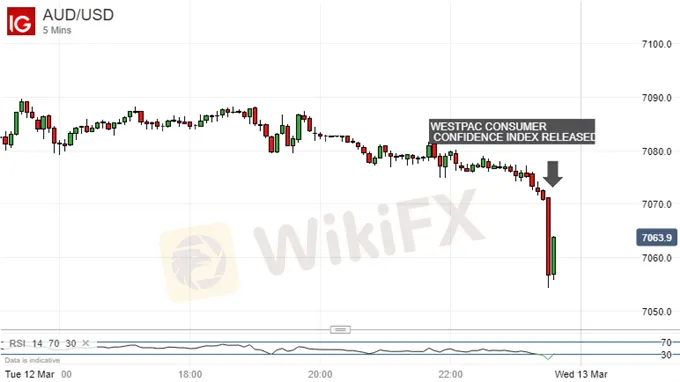简体中文
繁體中文
English
Pусский
日本語
ภาษาไทย
Tiếng Việt
Bahasa Indonesia
Español
हिन्दी
Filippiiniläinen
Français
Deutsch
Português
Türkçe
한국어
العربية
Australian Dollar Dives As Westpac Consumer Confidence Pulls Back
Abstract:The Australian Dollar has already been hit this week by signs of fading business confidence, now consumers have joined the corporate sector in the doldrums.
Australian Dollar, Westpac Consumer Confidence, Talking Points:
Westpacs confidence indicator fell at its fastest since late 2017
This adds to a litany of poor economic numbers out of Australia
The Aussie Dollar is in the firing line of course, but hopes of a US/China trade settlement keep it underpinned
Join our analysts for live, interactive coverage of all major economic data at the DailyFX Webinars. Wed love to have you along.
The Australian Dollar fell sharply Wednesday on news that domestic consumer confidence had done the same this month.
The March index from major lender Westpac fell by 4.9% on the month, more than wiping out the previous months 4.3% rise. March saw the heaviest fall for the series since September, 2017.
AUD/USD had been creeping lower before the release, but the fall unsurprisingly picked up speed after.

Remember these data come just a day after a weak business sentiment snapshot from Australia and suggest that economic conditions remain tough this quarter, following disappointing overall growth in the last three months of 2018. To be sure things aren‘t all bad for Australia. Job creation remains very strong. However, inflation remains stubbornly low and, while it does, the Australian Dollar will conspicuously lack interest rate support and remain vulnerable to numbers such as Westpac’s which suggest any ‘demand-push’ inflation effect will be feeble at best.
Indeed, futures markets suggest that the record-low, 1.50% Official Cash Rate will probably fall further in the months ahead.
On its broader, daily chart the Aussie remains stuck in the downtrend which took hold last year as US interest rates rose while Australias stayed put.

That weakness has endured into 2019, even as markets have priced in more rate-rise caution from the Federal Reserve , on that thesis that Australian monetary policy could yet loosen.
It is obviously hard to get very bullish about the currencys prospects given all of the above, but any sign of a durable trade settlement between China and the US could see growth-sensitive assets receive a general boost. The Australian Dollar is clearly in this group and a deal must now be regarded as the main risk to what will otherwise be quite a bearish landscape for the currency.
Australia has arguably as much skin in the trade game as any third country given its strong trade and political links with both Beijing and Washington.
Disclaimer:
The views in this article only represent the author's personal views, and do not constitute investment advice on this platform. This platform does not guarantee the accuracy, completeness and timeliness of the information in the article, and will not be liable for any loss caused by the use of or reliance on the information in the article.
Read more

All Round Major Pairs Technical Analysis: EUR/USD, AUDUSD, And GBPUSD
The start of November has been a dwindling moment for the general major currency market. As essential economic updates flood the surface of the entire foreign exchange market, in which most of the currency pairs especially the major pairs were greatly affected by the impact of the economic releases. However, the US dollar was discovered to have held the main currency exchange performance metrics as the central economic updates from the US region tend to have determined the significant changes that have occurred in the major currency market so far.

Currencies wait for RBA to kick off big central bank week
The dollar hovered below recent highs on Tuesday as traders waited for the Reserve Bank of Australia to lead a handful of central bank meetings set to define the rates outlook this week.

US Dollar Holds Gains as Japan Boosts and China PMI Weighs. USD Volatility Ahead?
US DOLLAR, JAPAN ELECTION, USD/JPY, CHINA PMI, AUD/USD - TALKING POINTS

Australian Dollar Price Chart: AUD/USD Reversal Stalls– Trade Outlook
The Australian Dollar is up more than 2.6% on the back of a five-day rally with price eyeing initial resistance. These are the levels that matter on the AUD/USD charts.
WikiFX Broker
Latest News
Germany's Election: Immigration, Economy & Political Tensions Take Centre Stage
WikiFX Review: Is IVY Markets Reliable?
Brazilian Man Charged in $290 Million Crypto Ponzi Scheme Affecting 126,000 Investors
ATFX Enhances Trading Platform with BlackArrow Integration
IG 2025 Most Comprehensive Review
SEC Drops Coinbase Lawsuit, Signals Crypto Policy Shift
Construction Datuk Director Loses RM26.6 Mil to UVKXE Crypto Scam
Should You Choose Rock-West or Avoid it?
Franklin Templeton Submitted S-1 Filing for Spot Solana ETF to the SEC on February 21
Scam Couple behind NECCORPO Arrested by Thai Authorities
Currency Calculator







